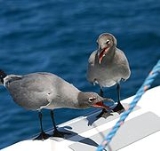
Lava Gull
Encyclopedia
The Lava Gull is a large gull
. One of the rarest gulls in the world, the entire population lives on the Galapagos Islands
and is estimated at 400 pairs.
The adult plumage
, acquired in the third year of life, consists of a black head, black wings, and with a dark gray body and a paler gray belly. The bill and legs are black, and the inside of the mouth is scarlet. They have white upper and lower eyebrows, with red lids. Immature gulls are generally dark brown.
Lava Gulls are solitary nesters, laying two olive-colored and well-camouflaged eggs that take 30 days to incubate. Young birds fledge at 60 days and are cared for by adults for a short period.
They are omnivores like most gulls, generally scavenging or stealing from nests, but will also catch fish
, small crustacean
s, and newly-hatched lizard
s.
The Lava Gull is categorized as "vulnerable" by the IUCN Red List
because it exists in small numbers and though the population is stable, it faces numerous threats.
Gull
Gulls are birds in the family Laridae. They are most closely related to the terns and only distantly related to auks, skimmers, and more distantly to the waders...
. One of the rarest gulls in the world, the entire population lives on the Galapagos Islands
Galápagos Islands
The Galápagos Islands are an archipelago of volcanic islands distributed around the equator in the Pacific Ocean, west of continental Ecuador, of which they are a part.The Galápagos Islands and its surrounding waters form an Ecuadorian province, a national park, and a...
and is estimated at 400 pairs.
The adult plumage
Plumage
Plumage refers both to the layer of feathers that cover a bird and the pattern, colour, and arrangement of those feathers. The pattern and colours of plumage vary between species and subspecies and can also vary between different age classes, sexes, and season. Within species there can also be a...
, acquired in the third year of life, consists of a black head, black wings, and with a dark gray body and a paler gray belly. The bill and legs are black, and the inside of the mouth is scarlet. They have white upper and lower eyebrows, with red lids. Immature gulls are generally dark brown.
Lava Gulls are solitary nesters, laying two olive-colored and well-camouflaged eggs that take 30 days to incubate. Young birds fledge at 60 days and are cared for by adults for a short period.
They are omnivores like most gulls, generally scavenging or stealing from nests, but will also catch fish
Fish
Fish are a paraphyletic group of organisms that consist of all gill-bearing aquatic vertebrate animals that lack limbs with digits. Included in this definition are the living hagfish, lampreys, and cartilaginous and bony fish, as well as various extinct related groups...
, small crustacean
Crustacean
Crustaceans form a very large group of arthropods, usually treated as a subphylum, which includes such familiar animals as crabs, lobsters, crayfish, shrimp, krill and barnacles. The 50,000 described species range in size from Stygotantulus stocki at , to the Japanese spider crab with a leg span...
s, and newly-hatched lizard
Lizard
Lizards are a widespread group of squamate reptiles, with nearly 3800 species, ranging across all continents except Antarctica as well as most oceanic island chains...
s.
The Lava Gull is categorized as "vulnerable" by the IUCN Red List
IUCN Red List
The IUCN Red List of Threatened Species , founded in 1963, is the world's most comprehensive inventory of the global conservation status of biological species. The International Union for Conservation of Nature is the world's main authority on the conservation status of species...
because it exists in small numbers and though the population is stable, it faces numerous threats.
Further reading
- Snow, B.K. & Snow, D.W. (1969). "Observations on the Lava Gull (Larus fuliginosus)." Ibis 111(1):30-35

